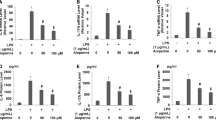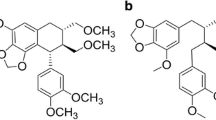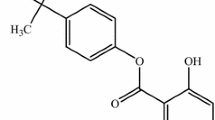Abstract
Objective and design
The anti-inflammatory effect of methyl-1-hydroxy-2-naphthoate (MHNA), a novel naphthol derivative, was evaluated in the lipopolysaccharide (LPS)-induced inflammatory response in murine macrophages.
Materials and methods
The release of nitric oxide (NO), interleukin-1beta (IL-1β) and interleukin-6 (IL-6) were detected by the Griess reagent and ELISA methods. The protein expressions of inducible NO synthase (iNOS) and cyclooxygenase-2 (COX-2) were examined by Western blotting. The mRNA expressions of IL-1β, IL-6, iNOS and COX-2 were determined by real-time PCR. Activation of mitogen-activated protein kinases (MAPKs) and nuclear factor kappa B (NF-κB) pathways were detected by Western blotting, reporter gene assay and electrophoretic mobility shift assay.
Results
MHNA significantly inhibited the release of NO, IL-1β and IL-6 as well as the protein expression of iNOS and COX-2 in LPS-stimulated macrophages. It also inhibited the mRNA expression of iNOS, COX-2, IL-1β and IL-6. Further studies indicated that MHNA inhibited LPS-induced increases in NF-κB DNA-binding activity and NF-κB transcriptional activity as well as IκB-α degradation and NF-κB translocation in a dose-dependent manner. Meanwhile, the activation of p38 MAPK and c-Jun N-terminal kinases (JNK) induced by LPS were decreased by MHNA.
Conclusions
MHNA inhibits the LPS-induced inflammatory response in murine macrophages via suppression of NF-κB and MAPKs signaling pathways activation.








Similar content being viewed by others
Abbreviations
- COX-2:
-
Cyclooxygenase-2
- EMSA:
-
Electrophoretic mobility shift assay
- ERK:
-
Extracellular signal-regulated kinases
- iNOS:
-
Inducible nitric oxide synthase
- IκB:
-
Inhibitory kappa B
- IL-1β:
-
Interleukin-1beta
- IL-6:
-
Interleukin-6
- JNK:
-
c-Jun N-terminal kinases
- LPS:
-
Lipopolysaccharide
- MAPKs:
-
Mitogen-activated protein kinases
- NO:
-
Nitric oxide
- NF-κB:
-
Nuclear factor kappa B
- PGE2 :
-
Prostaglandin E2
- TNF-α:
-
Tumor necrosis factor alpha
References
Yun KJ, Kim JY, Kim JB, Lee KW, Jeong SY, Park HJ, et al. Inhibition of LPS-induced NO and PGE2 production by asiatic acid via NF-kappa B inactivation in RAW 264.7 macrophages: possible involvement of the IKK and MAPK pathways. Int Immunopharmacol. 2008;8:431–41.
Feng D, Ling WH, Duan RD. Lycopene suppresses LPS-induced NO and IL-6 production by inhibiting the activation of ERK, p38MAPK, and NF-kappaB in macrophages. Inflamm Res. 2010;59:115–21.
Wang JX, Hou LF, Yang Y, Tang W, Li Y, Zuo JP. SM905, an artemisinin derivative, inhibited NO and pro-inflammatory cytokine production by suppressing MAPK and NF-kappaB pathways in RAW 264.7 macrophages. Acta Pharmacol Sin. 2009;30:1428–35.
Mahida YR. The key role of macrophages in the immunopathogenesis of inflammatory bowel disease. Inflamm Bowel Dis. 2000;6:21–33.
Szekanecz Z, Koch AE. Macrophages and their products in rheumatoid arthritis. Curr Opin Rheumatol. 2007;19:289–95.
Zernecke A, Weber C. Inflammatory mediators in atherosclerotic vascular disease. Basic Res Cardiol. 2005;100:93–101.
Pahl HL. Activators and target genes of Rel/NF-kappaB transcription factors. Oncogene. 1999;18:6853–66.
Li Q, Verma IM. NF-kappaB regulation in the immune system. Nat Rev Immunol. 2002;2:725–34.
Yamamoto Y, Gaynor RB. IkappaB kinases: key regulators of the NF-kappaB pathway. Trends Biochem Sci. 2004;29:72–9.
Baldwin AS Jr. Series introduction: the transcription factor NF-kappaB and human disease. J Clin Invest. 2001;107:3–6.
Chen C, Chen YH, Lin WW. Involvement of p38 mitogen-activated protein kinase in lipopolysaccharide-induced iNOS and COX-2 expression in J774 macrophages. Immunology. 1999;97:124–9.
Kim YH, Lee SH, Lee JY, Choi SW, Park JW, Kwon TK. Triptolide inhibits murine-inducible nitric oxide synthase expression by down-regulating lipopolysaccharide-induced activity of nuclear factor-kappa B and c-Jun NH2-terminal kinase. Eur J Pharmacol. 2004;494:1–9.
Carter AB, Knudtson KL, Monick MM, Hunninghake GW. The p38 mitogen-activated protein kinase is required for NF-kappaB-dependent gene expression. The role of TATA-binding protein (TBP). J Biol Chem. 1999;274:30858–63.
Guha M, Mackman N. LPS induction of gene expression in human monocytes. Cell Signal. 2001;13:85–94.
Kongkathip N, Hasitapan K, Pradidphol N, Kirtikara K, Jongkona N, Kongkathip B. Synthesis of novel 2-(2′-cyclopentyl)- and 2-(2′-cyclohexyl) substituted 1-naphthol derivatives with anticyclooxygenase activity. Curr Med Chem. 2006;13:3663–74.
Kongkathip B, Sangma C, Kirtikara K, Luangkamin S, Hasitapan K, Jongkon N, et al. Inhibitory effects of 2-substituted-1-naphthol derivatives on cyclooxygenase I and II. Bioorg Med Chem. 2005;13:2167–75.
Matsubara M, Yamachika E, Tsujigiwa H, Mizukawa N, Ueno T, Murakami J, et al. Suppressive effects of 1,4-dihydroxy-2-naphthoic acid administration on bone resorption. Osteoporos Int. 2010;21:1437–47.
Okada Y, Tsuzuki Y, Miyazaki J, Matsuzaki K, Hokari R, Komoto S, et al. Propionibacterium freudenreichii component 1.4-dihydroxy-2-naphthoic acid (DHNA) attenuates dextran sodium sulphate induced colitis by modulation of bacterial flora and lymphocyte homing. Gut. 2006;55:681–8.
Chanklan R, Mizunuma M, Kongkathip N, Hasitapan K, Kongkathip B, Miyakawa T. Identification of Saccharomyces cerevisiae Tub1 alpha-tubulin as a potential target for NKH-7, a cytotoxic 1-naphthol derivative compound. Biosci Biotechnol Biochem. 2008;72:1023–31.
Bauche F, Stephan JP, Touzalin AM, Jegou B. In vitro regulation of an inducible-type NO synthase in the rat seminiferous tubule cells. Biol Reprod. 1998;58:431–8.
Allen JB, Keng T, Privalle C. Nitric oxide and peroxynitrite production in ocular inflammation. Environ Health Perspect. 1998;106(Suppl 5):1145–9.
Nagy G, Clark JM, Buzas EI, Gorman CL, Cope AP. Nitric oxide, chronic inflammation and autoimmunity. Immunol Lett. 2007;111:1–5.
Bogdan C. Nitric oxide and the immune response. Nat Immunol. 2001;2:907–16.
Tripathi P, Tripathi P, Kashyap L, Singh V. The role of nitric oxide in inflammatory reactions. FEMS Immunol Med Microbiol. 2007;51:443–52.
Di RM, Radomski M, Carnuccio R, Moncada S. Glucocorticoids inhibit the induction of nitric oxide synthase in macrophages. Biochem Biophys Res Commun. 1990;172:1246–52.
Turini ME, DuBois RN. Cyclooxygenase-2: a therapeutic target. Annu Rev Med. 2002;53:35–57.
Williams TJ. The role of prostaglandins in inflammation. Ann R Coll Surg Engl. 1978;60:198–201.
Seibert K, Zhang Y, Leahy K, Hauser S, Masferrer J, Perkins W, et al. Pharmacological and biochemical demonstration of the role of cyclooxygenase 2 in inflammation and pain. Proc Natl Acad Sci USA. 1994;91:12013–7.
Kishimoto T. IL-6: from its discovery to clinical applications. Int Immunol. 2010;22:347–52.
Arend WP, Malyak M, Guthridge CJ, Gabay C. Interleukin-1 receptor antagonist: role in biology. Annu Rev Immunol. 1998;16:27–55.
Van Snick J. Interleukin-6: an overview. Annu Rev Immunol. 1990;8:253–78.
Hallegua DS, Weisman MH. Potential therapeutic uses of interleukin 1 receptor antagonists in human diseases. Ann Rheum Dis. 2002;61:960–7.
Braddock M, Quinn A. Targeting IL-1 in inflammatory disease: new opportunities for therapeutic intervention. Nat Rev Drug Discov. 2004;3:330–9.
Hirano T. Interleukin-6 and its relation to inflammation and disease. Clin Immunol Immunopathol. 1992;62:S60–5.
Nishimoto N. Interleukin-6 as a therapeutic target in candidate inflammatory diseases. Clin Pharmacol Ther. 2010;87:483–7.
Molto A, Olive A. Anti-IL-1 molecules: new comers and new indications. Joint Bone Spine. 2010;77:102–7.
Zhou HY, Shin EM, Guo LY, Youn UJ, Bae K, Kang SS, et al. Anti-inflammatory activity of 4-methoxyhonokiol is a function of the inhibition of iNOS and COX-2 expression in RAW 264.7 macrophages via NF-kappaB, JNK and p38 MAPK inactivation. Eur J Pharmacol. 2008;586:340–9.
Acknowledgments
This work was supported by grants from the Science and Technology Bureau of Guangzhou (2006Z1-E6021).
Author information
Authors and Affiliations
Corresponding authors
Additional information
Responsible Editor: Liwu Li.
Jun-Yan Zhang and Hong Jin contributed equally to this work.
Rights and permissions
About this article
Cite this article
Zhang, JY., Jin, H., Wang, GF. et al. Methyl-1-hydroxy-2-naphthoate, a novel naphthol derivative, inhibits lipopolysaccharide-induced inflammatory response in macrophages via suppression of NF-κB, JNK and p38 MAPK pathways. Inflamm. Res. 60, 851–859 (2011). https://doi.org/10.1007/s00011-011-0345-2
Received:
Revised:
Accepted:
Published:
Issue Date:
DOI: https://doi.org/10.1007/s00011-011-0345-2




